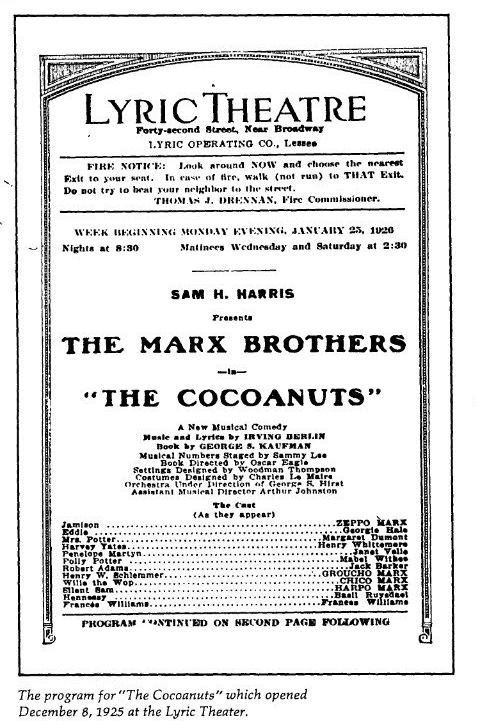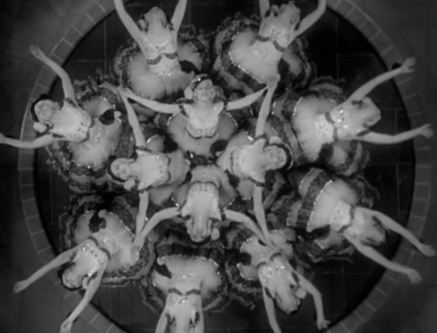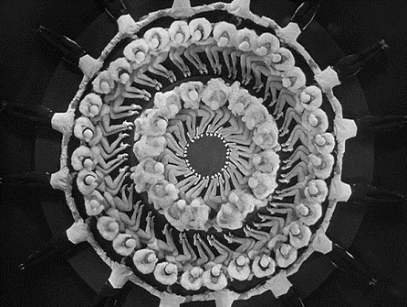Just think – tonight…tonight when the moon is sneaking around the clouds I’ll be sneaking around you. I’ll meet you tonight under the moon. Oh, I can see it now – you and the moon. Wear a neck-tie so I’ll know you.
Ninety years (and a few weeks) ago – August 3rd, 1929 – the Marx Brothers’ first feature-length film The Cocoanuts was released and became a hit with audiences and critics.* It would prove to be one of the most successful early talkie films, grossing $1.8 million and ensuring a spot in the motion picture industry for the Marx Brothers.
(* The Brothers’ first film was actually an unreleased – and lost – silent short made in 1921 called Humor Risk.)

The Brothers were a huge hit on Broadway at the time of the film’s release. They were actually performing Animal Crackers on Broadway during evenings after they spent their days filming The Cocoanuts. Tough work.
Just one year later, Animal Crackers would be adapted for the screen, becoming the Marx Bros’ second film.

The Cocoanuts was filmed at Paramount’s Astoria Studios in Queens, NY. Paramount filmed many features and shorts at that location from 1920 until they moved all of their operations to Southern California in 1932. The Marx Brothers would also film Animal Crackers at the Astoria Studios before they too moved to California.

Paramount’s Astoria Studios, ca. 1930
The Cocoanuts is clunky, some of the scenes fall a bit flat, and the musical numbers (written by none other than Irving Berlin) aren’t all that memorable.
Filming a musical comedy in 1929 was extremely difficult, especially when its stars were so quick-moving with their bodies and mouths. The cameras were huge and mostly stagnant and the sound equipment was extremely sensitive (so much so that every piece of paper used in the film had to be soaked in water so that it would not make loud crinkling noises). On top of that, it’s difficult to hear what the actors are saying; it’s pretty muffled. As a result, it’s a bit of a challenge to keep up with, but it’s a challenge worthy of pursuing.
If you haven’t seen any Marx Bros films, I don’t recommend watching this one as your first, but certainly watch it.
Despite everything I just said, I think The Cocoanuts is a delightful watch. Looking past the technical issues, it’s a really funny film and pushes past those issues enough to make it enjoyable.
And for all of its camera stagnancy, there are several great overhead shots of chorus girls making geometric formations – kind of a precursor to the camerawork of Busby Berkeley.

The Cocoanuts (1929)

42nd Street (1933) – choreographed by Busby Berkeley
Written by George S. Kaufman and Morrie Ryskind, who also co-wrote the original version on Broadway, the film is filled with tons of biting and witty humor. Here are just a few examples:
There’s not much of a plot, but the film is set in Florida during the Florida Land Boom of the ’20s, which is a fascinating subject in and of itself. Basically, Mr. Hammer (Groucho Marx) runs a beachfront hotel called the Hotel de Cocoanut and is assisted (and not well) by a man  named Jamison (Zeppo Marx). Harpo and Chico (played by Harpo Marx and Chico Marx, respectively and obviously) arrive at the hotel with empty suitcases, ready to steal things. The cast is rounded off by several other actors, including eventual Marx Brothers staple Margaret Dumont – who plays the wealthy, stuffy, and widowed Mrs. Potter – and Kay Francis, who plays Penelope, the partner of a conman named Harvey Yates (Cyril Ring). Mrs. Potter’s daughter, Polly (Mary Eaton) gets mixed up into some drama as she tries to convince her mother that her true love, Bob Adams (Oscar Shaw), is the right man for her.
named Jamison (Zeppo Marx). Harpo and Chico (played by Harpo Marx and Chico Marx, respectively and obviously) arrive at the hotel with empty suitcases, ready to steal things. The cast is rounded off by several other actors, including eventual Marx Brothers staple Margaret Dumont – who plays the wealthy, stuffy, and widowed Mrs. Potter – and Kay Francis, who plays Penelope, the partner of a conman named Harvey Yates (Cyril Ring). Mrs. Potter’s daughter, Polly (Mary Eaton) gets mixed up into some drama as she tries to convince her mother that her true love, Bob Adams (Oscar Shaw), is the right man for her.
As much as it sounds like there’s a lot going on story-wise, there’s not. Therein lies the beauty of the early Marx Brothers films: the lack of a plot allows more time for the brothers to put their trademark gags onscreen. (Team Paramount, woo!)

The big musical number, The Monkey Doodle Doo, occurs about halfway through the film. It is sung and danced by Polly (Eaton), accompanied by chorus dancers. Here is an audio-only clip of the song:
Polly is one of the many characters who gets a happy ending. She ends the film by singing “When My Dreams Come True”, which is basically the theme song of the film.
This particular scene takes place at a party not long before the film ends. Personally, I’ve always liked this song:
Happy 90th to what would become the beginning of a brief film career for Zeppo and a long film career for Groucho, Harpo, and Chico. Here’s to another 90+ years of celebrating the Marx Brothers.



Good article! I’ve never heard of this movie, but you make it sound interesting! The Marx Brothers’ film, Duck Soup, is on AFI’s list of the Top 100 Films of All Time, so it looks like they did something right. By the way, I nominated you for the Liebster Award! Here’s the link to my award post:
https://18cinemalane.wordpress.com/2019/09/13/i-won-the-liebster-award/
Oh, thank you so much!
You’re welcome!